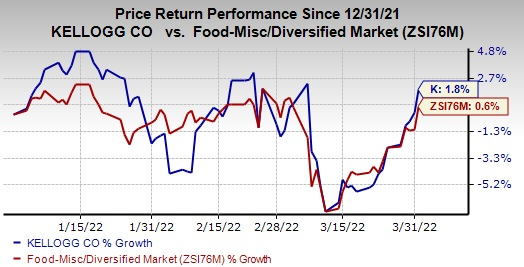Kellogg Company K is benefiting from strength in the Europe, Middle East and Africa (EMEA) region. The convenience food maker is keen on expanding its business through acquisitions. However, it is battling cost inflation and supply-chain disruptions. A deceleration in at-home demand is also a concern for Kellogg.
Let’s delve deeper.

Image Source: Zacks Investment Research
EMEA Region Solid
EMEA, which is Kellogg’s largest international region in terms of net sales, has a multi-year track record of organic net sales growth. During 2021, the company’s EMEA organic net sales rose for the seventh consecutive year. Both volume and price mix improved in 2021, reflecting broad-based gains geographically and across category groups. The company is witnessing solid organic growth in snacks, cereal and noodles in the EMEA region. It is worth mentioning that the EMEA region’s cereal consumption outpaced the region's overall category on a one-year and two-year CAGR basis, driven by important markets like Australia, India and Saudi Arabia in 2021. Pringles delivered impressive consumption performance despite pandemic-inflicted supply disruptions in the year.
Acquisitions Fuel Growth
In line with the strategy to diversify its organic offerings, Kellogg acquired protein bar maker, Chicago Bar Company, in 2017. Chicago Bar Company makes RXBAR, which is considered one of the fastest-growing nutrition bar brands in the United States. The company’s Pringles buyout has been lucrative. With the 2012 Pringles deal, Kellogg transformed itself from a large U.S. snacks business to a true global snacks player. Pringles has emerged as Kellogg’s largest global brand, which has been displaying robust momentum for some time now. The consolidation of Multipro (completed in May 2018), a Nigeria-based food distributor, has been yielding. These acquired businesses are expected to continue supporting the company’s business. Kellogg also continues to expand its acquired brands through new product introductions.
Several other companies in the food space are benefiting from acquisitions like Post Holdings, Inc. POST, Hormel Foods Corporation HRL and The Hershey Company HSY. During the first quarter of fiscal 2022, Post Holdings’ top line included $97.8 million in net sales from acquisitions. This includes the Private label ready-to-eat (PL RTE) cereal business, Egg Beaters liquid egg brand, Almark Foods business and related assets as well as the Peter Pan nut butter brand.
Hormel Foods is strengthening its business on the back of strategic acquisitions. In June 2021, the company acquired the Planters snacking portfolio. Prior to this, the company acquired Texas-based pit-smoked meats company Sadler's Smokehouse in March 2020. The buyout is in sync with Hormel Foods’ initiatives to strengthen its position in the foodservice space.
Hershey has been undertaking buyouts to augment portfolio strength and boost revenues. In December 2021, Hershey acquired Dot’s Pretzels LLC — the owner of Dot’s Homestyle Pretzels — a leading brand in the pretzel category. The addition of Dot’s Pretzels is a perfect match for Hershey’s growing salty snacking portfolio. The company also purchased Pretzels Inc. from an affiliate of Peak Rock Capital. The acquisition expands Hershey’s snacking and production capabilities.
Hurdles on Way
Kellogg is encountering the impact of labor strikes across four U.S. cereal plants. On its lastearnings call management highlighted that its team was back at work. However, the strike affected the company’s near-term finances. The strike affected sales and profit in the fourth quarter of 2021 and it will have carry-over cost impacts in the first quarter of 2022. In addition, the impact of these strikes will put pressure on second-quarter sales.
During the quarter, Kellogg’s gross profit of $1,006 million declined from $1,185 million reported in the year-ago quarter. The downside stemmed from accelerated market-driven cost inflation, supply-chain disruptions and costs related to the strike in the U.S. cereal business. The company’s productivity and revenue growth management actions did not offset such hurdles. Management expects cost inflation to reach a double-digit rate, with first-half inflation higher than the second-half inflation in 2022. It anticipates witnessing persistent supply-chain bottlenecks and shortages at least through the first half of 2022.
That being said, we believe that this Zacks Rank #3 (Hold) company’s aforementioned upsides are likely to keep aiding growth. Shares of the company have increased 1.8% so far this year compared with the industry’s growth of 0.6%.
You can see the complete list of today’s Zacks #1 Rank (Strong Buy) stocks here.
Just Released: Zacks Top 10 Stocks for 2022
In addition to the investment ideas discussed above, would you like to know about our 10 top buy-and-hold tickers for the entirety of 2022?
Last year's 2021 Zacks Top 10 Stocks portfolio returned gains as high as +147.7%. Now a brand-new portfolio has been handpicked from over 4,000 companies covered by the Zacks Rank. Don’t miss your chance to get in on these long-term buys
Access Zacks Top 10 Stocks for 2022 today >>Want the latest recommendations from Zacks Investment Research? Today, you can download 7 Best Stocks for the Next 30 Days. Click to get this free report
Hershey Company The (HSY): Free Stock Analysis Report
Hormel Foods Corporation (HRL): Free Stock Analysis Report
Kellogg Company (K): Free Stock Analysis Report
Post Holdings, Inc. (POST): Free Stock Analysis Report
To read this article on Zacks.com click here.
Zacks Investment Research
The views and opinions expressed herein are the views and opinions of the author and do not necessarily reflect those of Nasdaq, Inc.


